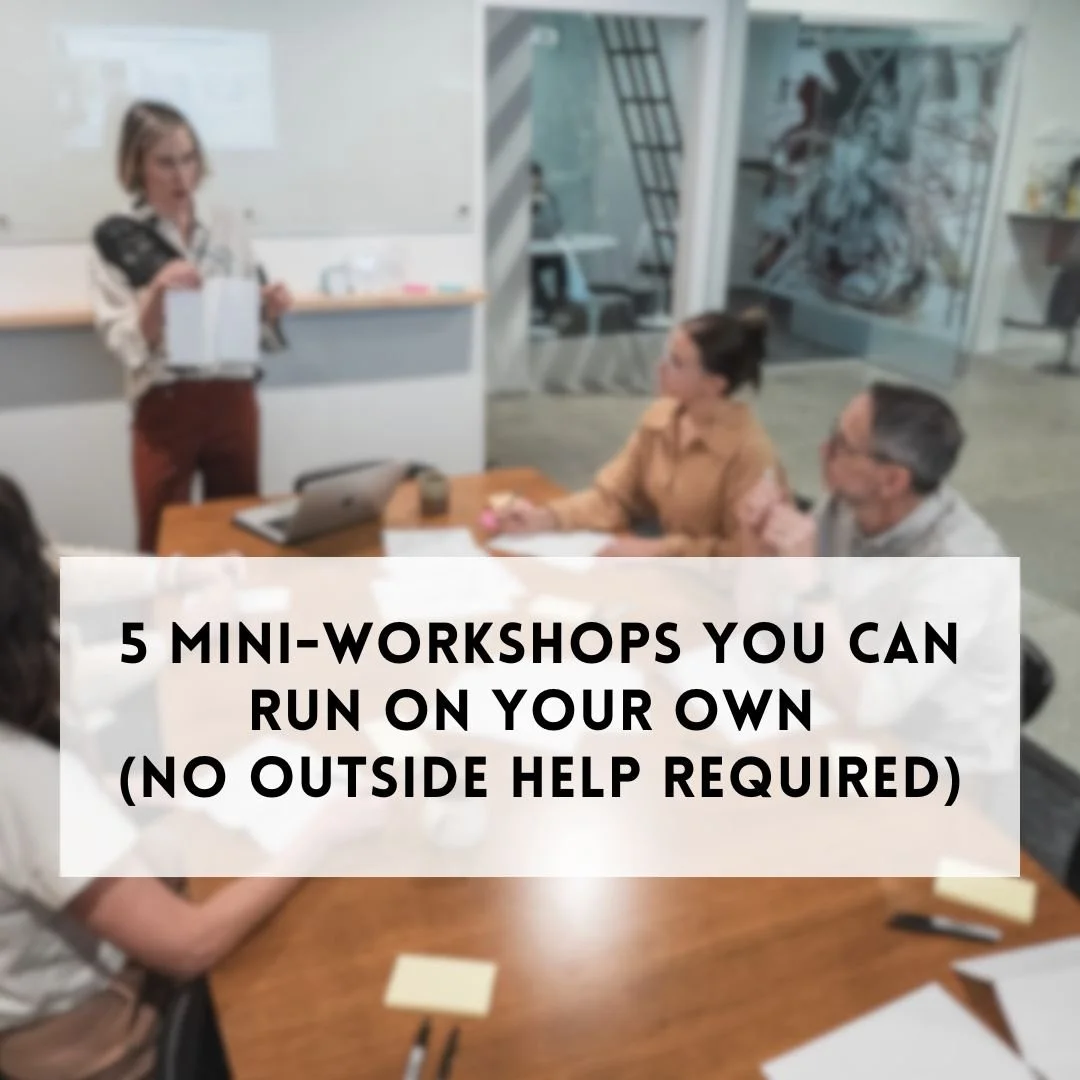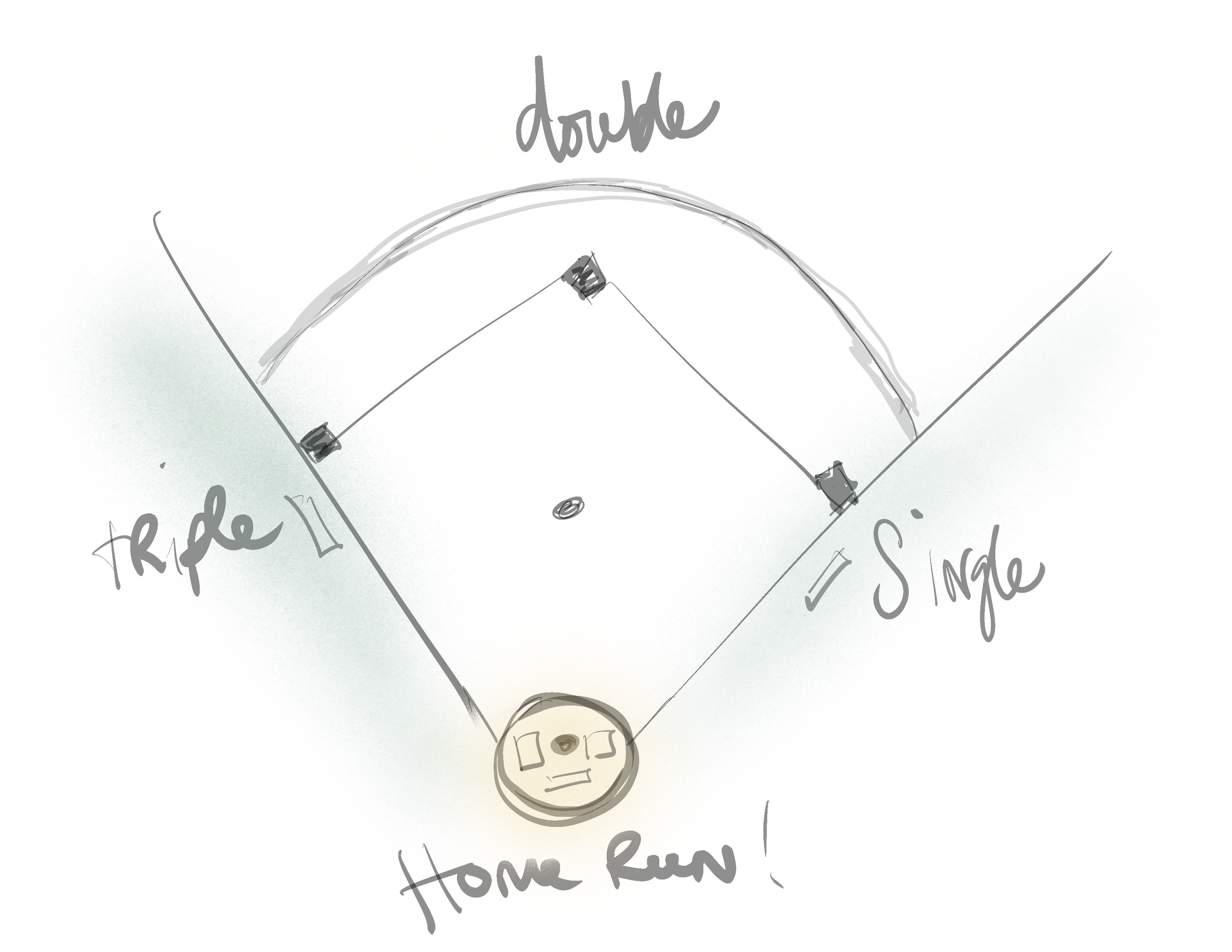5 Mini-Workshops You Can Run on Your Own (No Outside Help Required)
You don’t always need to wait for a big strategy offsite to kick off meaningful conversations with your team. In fact, lightweight micro-sessions can be a powerful way to build alignment, spark ideas, and gain clarity on priorities—all within 15 to 30 minutes. These DIY mini-workshops offer just enough structure to get you started, and may even get you curious about what a deeper, pro-facilitated experience could unlock.
Here are five easy-to-run micro-workshops designed for teams working on innovation, new product/feature design, ideation, or simply looking for more productive ways to collaborate.
1. Playing Field
Purpose: Define what success looks like for your team, clearly and collaboratively.
How to Run It: Draw a baseball field on the physical or virtual white board (single, double, triple, home run). Set a clear time horizon—12 months, 3 years, etc.
Ask your team: "By this point, if everything goes right, what do we want to say we achieved?" Give everyone sticky notes to jot down ideas independently (this helps avoid groupthink and supports quieter voices—more on that later). Then, ask team members to share their ideas while you group the responses on the board.
Next, facilitate a conversation to identify key themes and define success metrics for the most important items. Don’t worry about reinventing the wheel—use your org’s existing frameworks if they’re helpful. The real value comes from getting everyone aligned on what "winning" looks like.
When to Use: Early-stage planning, quarterly kickoff, new team formation.
2. Horizon’s Method
Purpose: Turn ideas into actionable steps with clear ownership and timelines.
How to Run It: After identifying key goals or outcomes, draw two or more time horizons on the board (e.g., a specific month/quarter/year).
Distribute sticky notes and ask participants to list tasks that need to be completed by each horizon. Let everyone add their items independently to reduce power dynamics.
Next, group similar tasks together, clarify vague items, and confirm priorities with the team. Then, assign an owner to each near-term task to create accountability and momentum for the work that will last beyond the session.
When to Use: After visioning sessions, Design Sprint planning, or strategic reviews.
3. Asset Inventory
Purpose: Build a shared understanding of what your team already has to work with. This is especially useful when kicking off a new initiative or collaborating cross-functionally—it surfaces hidden resources and inspires creative reuse.
How to Run It: Prompt the group to list known strengths, successful past efforts, valuable tools, partnerships, and existing content or capabilities.
What assets are being underutilized? What can be combined in new ways? Capture contributions on a shared board or independently via a worksheet.
Want a free worksheet template? Download my personal template right here, which you can use with your own team.
When to Use: New project kickoffs, innovation or visioning workshops, or post-reorg planning.
4. Storyboarding
Purpose: Align on a concept before investing in design or development.
How to Run It: Pick an idea the team wants to explore—a new feature, product pitch, or enhancement to an existing flow. Sketch the major steps of the experience on a whiteboard, like a comic strip.
Use images or artifacts from earlier sessions if available. Don’t aim for perfection, but do aim for clarity.
Facilitate a conversation to rank each scene by importance. What do users need to know, feel, or do at each step? Which steps are critical to test or validate?
When to Use: Before prototyping, roadmap planning, or preparing stakeholder presentations.
5. Solo Ideation + Group Voting
Purpose: Generate diverse ideas and avoid groupthink.
How to Run It: Offer the team a focused prompt (e.g., “How might we improve first-time user activation?”). Give everyone 10 minutes to think and write down their ideas independently.
Next, have each person read their ideas aloud and post them to a shared wall or board. Spend 10 minutes voting on which ideas to explore further. I recommend using anonymous voting methods to ensure the best ideas rise to the top (not just the idea the C-level exec voted for and inadvertently influenced others to follow suit).
This approach levels the playing field and makes space for introverts and non-dominant voices to shine.
When to Use: Early in discovery, during brainstorming sessions, or when tackling stubborn problems.
Mini-Workshops vs Maxi-Workshops
Mini-workshops are perfect for quick wins: they require less prep time, empower your team to participate, and build momentum in a low-stakes environment. But they have their limits.
If your team is wrestling with entrenched dynamics, big decisions, or a high-stakes pivot, a larger-scale workshop is your best bet for unlocking progress that feels out of reach. Especially if your team is struggling with any of the following:
Political tensions and fraught team dynamics
Misalignment between stakeholders
Prioritization gridlock
Lack of psychological safety that prevents full participation
Fatigue from meetings that generate ideas but no momentum
When stakes are high or time is short, a facilitated session can compress weeks of confusion into a single, clarifying effort. And a neutral third party / external facilitator can bring the objectivity, structure, and practiced hand to guide your team through the weeds. So you can finally move forward with the best ideas in hand—the ones your team is excited to execute!
Curious what a full Design Sprint or strategy workshop could do for your team? Let’s talk.


